
Invasive Species
From the desert floor to the highest mountain peaks, Arizona's diverse ecosystems are home to a rich variety of native plant and animal species. While many species flourish in our southwest region naturally, others are doing just as well but aren't native and threaten our desert environment. If you’re unsure how to differentiate the two, an invasive species is a non-native organism introduced to a new environment where it populates and poses harm to the ecosystem. Such species can cause ecological, environmental, and economic damage, adversely affecting habitats and the wildlife dependent on them, and, in some instances, human health.
CAZCA (Central Arizona Conservation Alliance)
Convened by Desert Botanical Garden, the Central Arizona Conservation Alliance (CAZCA) is a coalition of over 90 organizations dedicated to conserving, restoring, and promoting awareness of open spaces in Central Arizona. CAZCA operates as a nonprofit organization, focusing on community engagement, collaboration, and strategic regional coordination to ensure the sustainability of the region's outdoor spaces. By fostering partnerships and developing long-term preservation strategies, CAZCA aims to support healthy ecosystems and communities, providing opportunities for recreation, education, and relaxation within these natural landscapes. Arizona is not immune to the threat of invasive species which is why organizations like the Central Arizona Conservation Alliance are leading the fight against them. Learn about CAZCA below, explore the invasive species issue in Arizona, and get to know some of the key invaders. With enough public involvement, we can together mitigate their impact on our great state.
Initiatives
It’s so easy to join CAZCA in the fight against invasive species! Take a look at the following four CAZCA initiatives to learn how you can get involved, then start making a difference as little, or as much as you can. If we all do just a little bit more, everyone wins.
Sonoran Insiders – An innovative social media ambassador program designed to link local influencers with conservation non-profits and land managers
Desert Defenders – A collaborative, community science program focused on finding, mapping, and removing invasive species at local parks and preserves
Sonoran Seed Collaborative – A Native plant project dedicated to restoring parks and preserves
Urban Desertscape Enhancement – A collaborative group focused on educating homeowners on the importance of water conservation and native plant landscaping.
Arizona Invasive Plants and Grasses
Let's take a look at the top eight invasive plants and grasses invading our state and some of the negative impacts they have on our bioregion. Some invasive species in Arizona outcompete native plants, reducing the resources wildlife rely on and creating a cascading effect of less food and habitat. Others grow and spread rapidly, then quickly dry out in the hot Arizona sun, transforming into fine-fuel vegetation—meaning they ignite easily and burn quickly, worsening the risk of wildland fires.
Invasive species mitigation and prevention are ongoing efforts across Arizona, including many Arizona State Parks. We hope to help minimize occurrences of invasives statewide through educational campaigns with our partners, encouraging public involvement, and policing invasives at a park level throughout the state.
Want to get involved? Check out the volunteer opportunities through groups like CAZCA's Desert Defenders, Arizona-Sonora Desert Museum's Save Our Saguaros, and the Catalina State Park Buffel Slayers.
Stinknet
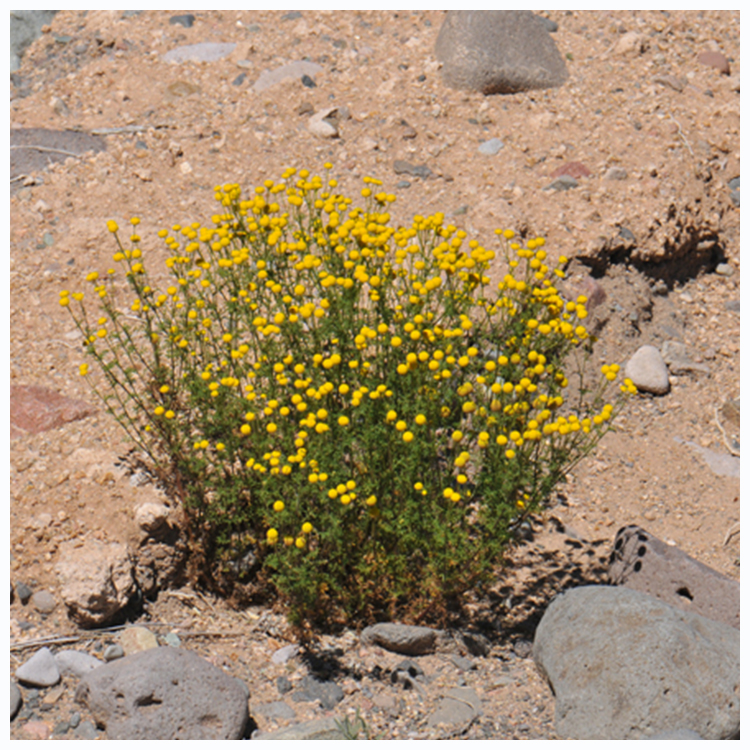
Stinknet (Oncosiphon piluliferum) poses a significant threat as an invasive species in Arizona's Sonoran Desert. Originally introduced from South Africa, this aggressive plant has rapidly spread across the desert landscape, displacing native vegetation and altering fragile ecosystems. Stinknet's prolific growth, coupled with its ability to produce abundant seeds and establish dense populations, allows it to outcompete native plants for resources such as water, nutrients, and sunlight. Its distinctive odor, particularly noticeable after rainfall, can be unpleasant for both humans and wildlife. Efforts to control stinknet's spread include manual removal, herbicide application, and public education campaigns to raise awareness about its ecological impacts and the importance of preventing its further expansion in the Sonoran Desert ecosystem.
This plant is also spreading rapidly through Arizona's low desert urban environments. If you see stinknet on your personal property, do your part by pulling the entire weed, including the roots, tying it tightly in a bag, and throwing the plant away. If you can, remove stinknet before it produces its yellow signature flowers, which each contain hundreds of seeds. When it is young, this plant resembles carrot greens. It also can cause skin irritation so we recommend wearing gloves while handling stinknet.
Salt Cedar
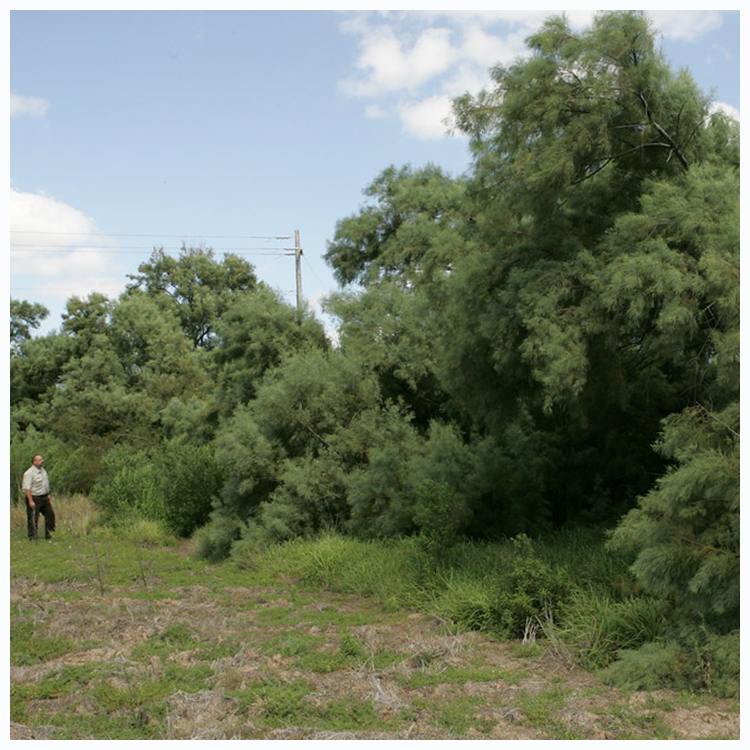
Salt cedar (Tamarix spp.) is a notable invasive species in Arizona, particularly along waterways and riparian areas. Originally introduced for erosion control and ornamental purposes, salt cedar has proliferated rapidly, displacing native vegetation and altering the ecological balance of affected habitats. Its ability to thrive in saline soils and withstand drought conditions contributes to its aggressive spread, outcompeting native plants and reducing biodiversity. Salt cedar's dense growth can also negatively impact water availability and quality, as it consumes large amounts of water and increases soil salinity due to the salt content of the leaves. Efforts to manage salt cedar infestations include mechanical removal, herbicide application, and restoration projects aimed at restoring native vegetation and ecological functions in affected areas. Effective management strategies are crucial to mitigate the ecological and economic impacts of salt cedar invasion on Arizona's natural landscapes.
Buffelgrass
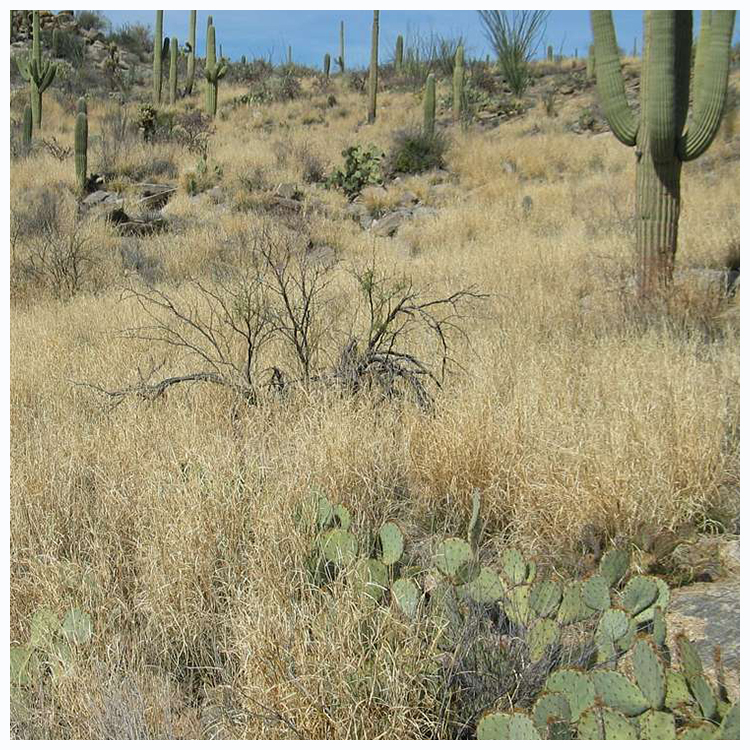
Buffelgrass (Pennisetum ciliare) is a threat to many of Arizona's ecosystems, particularly in desert regions. Originally introduced for soil stabilization and livestock forage, buffelgrass has rapidly spread across the landscape, forming dense stands that outcompete native vegetation and alter natural fire regimes. Its ability to thrive in arid environments, coupled with its prolific seeding and rapid growth, enables buffelgrass to establish quickly and dominate vast areas, including desert washes, hillsides, and open spaces. This invasive grass poses a serious fire risk, as it ignites easily and burns intensely, threatening both human communities and native plant species. Efforts to control buffelgrass infestations involve a combination of manual removal, herbicide application, and community-based eradication initiatives aimed at preventing its further spread and restoring native plant communities in affected areas. Although buffelgrass primarily spreads through seeds, it can also sprout from rhizomes, which makes it particularly difficult to mitigate. Increased public awareness and engagement are essential to effectively manage buffelgrass and protect Arizona's unique desert ecosystems from its ecological impacts.
Fountain Grass

Fountain grass (Pennisetum setaceum) is a quickly spreading invasive species in Arizona’s arid and semi-arid regions. Originally introduced as an ornamental plant, fountain grass has become highly invasive, spreading rapidly and displacing native vegetation in various habitats, including desert washes, grasslands, and disturbed areas. Its prolific seeding, rapid growth rate and ability to thrive in diverse environmental conditions contribute to its aggressive spread. Fountain grass forms dense stands, altering ecosystem dynamics, reducing biodiversity, and increasing the risk of wildfires due to its highly flammable nature. Efforts to control fountain grass infestations involve a combination of mechanical removal, herbicide application, and restoration projects aimed at restoring native plant communities and ecological functions in affected areas. Public awareness and engagement are crucial for effectively managing fountain grass and protecting Arizona's natural landscapes from its detrimental impacts.
When selecting ornamental grass for landscaping at your own home, opt for other attractive native grass, like sacaton (Sporobolus wrightii) which is drought-resistant and has a beautiful texture, or spectacular deer grass (Muhlenbergia regens).
Malta Starthistle
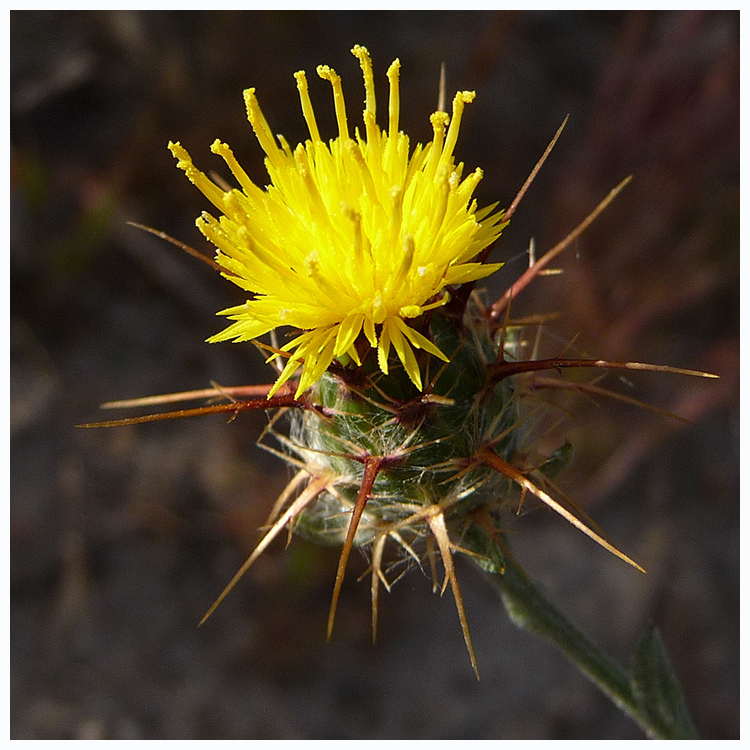
Malta starthistle (Centaurea melitensis) is identified as a spreading invasive species in Arizona, particularly in arid and semi-arid regions. Originating from the Mediterranean region, this plant was likely introduced to Arizona inadvertently through contaminated seeds or agricultural activities. Malta starthistle poses a significant threat to native plant communities and ecosystems due to its aggressive spreading behavior and ability to outcompete native vegetation for resources such as water, nutrients, and sunlight. Its spiny leaves and prolific seed production enable it to establish dense monocultures, displacing native flora and reducing biodiversity. Furthermore, Malta starthistle can degrade grazing lands, impact wildlife habitat, and increase the risk of wildfires due to its highly flammable nature. Efforts to control Malta starthistle infestations involve a combination of methods, including herbicide application, manual removal, and biological control through the introduction of specialized herbivores or pathogens. Public awareness and early detection are critical in preventing the further spread of Malta starthistle and protecting Arizona's natural ecosystems from its invasive impacts.
Scotch Thistle

Scotch thistle (Onopordum acanthium) is a spreading invasive species in Arizona, particularly in disturbed areas, roadsides, and rangelands. Native to Europe and Asia, this biennial plant was introduced to North America and has since become established in various regions, including Arizona. Scotch thistle poses a significant threat to native plant communities and ecosystems due to its aggressive spreading behavior and ability to outcompete native vegetation for resources such as water, nutrients, and sunlight. Its large size, spiny leaves, and prolific seed production enable it to establish dense stands, displacing native flora and reducing biodiversity. Furthermore, Scotch thistle can negatively impact agricultural productivity, impede recreational activities, and alter wildlife habitat. Efforts to control Scotch thistle infestations involve a combination of methods, including herbicide application, manual removal, and biological control through the introduction of specialized herbivores or pathogens. Public awareness, early detection, and prompt management actions are crucial in preventing the further spread of Scotch thistle and mitigating its invasive impacts on Arizona's natural ecosystems.
Yellow Blue Stem
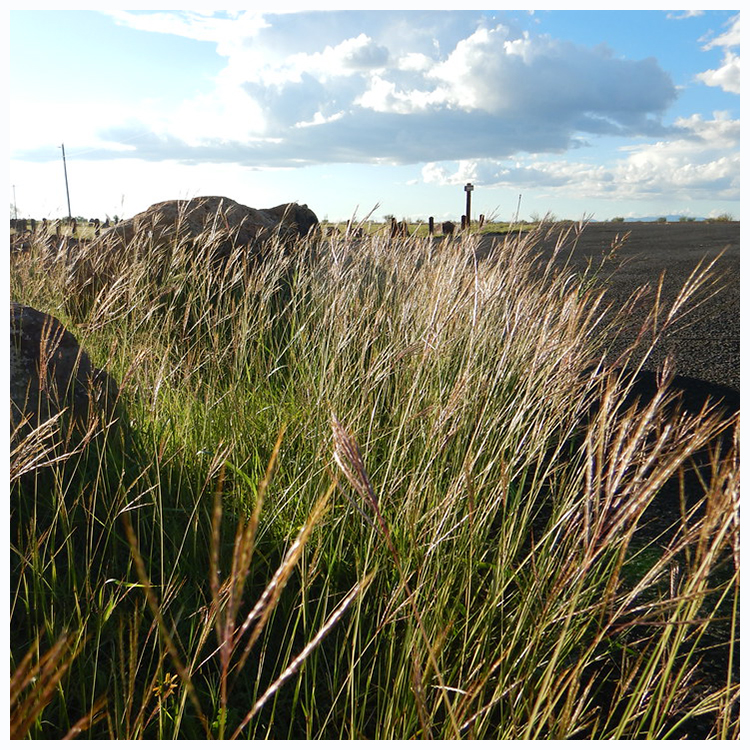
Yellow bluestem (Bothriochloa ischaemum) is recognized as an invasive species in Arizona, particularly in grassland and desert ecosystems. Originally introduced for forage and erosion control, yellow bluestem has become a significant threat to native vegetation due to its aggressive spreading behavior. This grass species can quickly form dense monocultures, outcompeting native plants and reducing biodiversity. Its ability to thrive in various soil types and climates allows it to establish in a wide range of habitats, including disturbed areas, roadsides, and rangelands. Yellow bluestem's rapid spread can also alter ecosystem dynamics and degrade wildlife habitat. Efforts to manage yellow bluestem infestations involve strategies such as herbicide application, prescribed burning, and mechanical removal, aimed at controlling its spread and restoring native plant communities in affected areas. Public education and awareness campaigns play a crucial role in preventing the further spread of yellow bluestem and protecting Arizona's diverse ecosystems from its invasive impacts.
Red Brome

Red brome (Bromus rubens) is a highly invasive species that poses a significant threat to Arizona's ecosystems, particularly in arid and semi-arid regions. Originally introduced from Europe, red brome has rapidly spread across the landscape, becoming one of the most problematic invasive grasses in the state. It thrives in disturbed areas, such as roadsides, fields, and overgrazed rangelands, where it outcompetes native vegetation for resources like water and nutrients. Red brome's aggressive growth cycle allows it to quickly establish dense stands, altering soil composition, increasing fire frequency, and reducing habitat quality for native plant and animal species. Furthermore, its presence exacerbates the risk of wildfires, as its fine fuels readily ignite and spread flames across the landscape. Efforts to control red brome infestations include mechanical removal, herbicide application, and prescribed burns to reduce its seed bank and prevent further spread. Public awareness and proactive management strategies are crucial in combating the spread of red brome and preserving the integrity of Arizona's diverse ecosystems.
Aquatic Invasive Species
Aquatic invasive species pose a significant threat to Arizona's native aquatic wildlife and ecosystems. Spread through interconnected waterways and watercraft movement, these invasive plants and animals, such as Quagga Mussels, disrupt fragile ecosystems and incur millions of dollars in damage. The Arizona Game and Fish Department’s Don’t Move a Mussel campaign provides crucial guidelines for boaters to prevent the spread of these invaders. Here's how you can help:
1. Clean: Remove mud, plants, and animals from every part of your boat, trailer, anchor, lines, and equipment to prevent harboring mussels.
2. Drain: Pull your drain plug every time you take your watercraft out of the water to eliminate all water, including livewells and ballast.
3. Dry: Allow your boat and equipment to thoroughly dry before launching in other waters. Dry time may vary depending on humidity and temperature.
Decontamination Protocols
If your watercraft has been in infested waters for more than five consecutive days, schedule a professional decontamination to remove any attached mussels. Before decontamination, remove all clinging materials and drain all water from the boat and engine. Keep the boat dry for a specified period to eliminate all mussels. For more information and to find a professional decontaminator, visit azgfd.gov/ais. Your cooperation is vital in protecting Arizona's waterways from the spread of aquatic invasive species.

